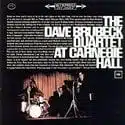
Pianist Dave Brubeck and his Quartet — with Paul Desmond on sax, Eugene Wright (later Bob Bates) on bass and Joe Morello (later Joe Dodge) on drums, were some of the more prolific and popular jazz performers of the 1960s. The two songs that are considered their signature pieces — “Blue Rondo a la Turk” and the one everyone knows, “Take Five”, are jazz standards and have sold thousands of copies then, and now. Of course, critical acclaim doesn’t automatically follow commercial success — and Brubeck caught more than his share of flak for his easy going musical style. Granted, he isn’t Bud Powell or Thelonious Monk by any means, but the interplay between the Quartet is extremely tight, and Brubeck is a nimble, inventive pianist.
Brubeck was the first jazz musician to be on the cover of Time magazine, he penned a ballet entitled Points on Jazz that was performed by the American Ballet Theatre, as well as creating The Real Ambassadors, a Broadway show most remembered for it’s performance by Louis Armstrong at the Monterey Jazz Festival in 1962. Clearly, this is a talented man and one who still tours the world at an age when most of his compatriots are using walkers. Awarded the National Medal of the Arts by Clinton in 1994, Brubeck is one of the giants of modern music.
Perhaps in honor of Brubeck’s 80th birthday, Columbia has reissued four of the quartet’s albums with extra tracks on some. The best of the lot, Jazz Impressions of Japan succeeds because it captures the bustle and beauty of Japan that the Quartet experienced on a trip there in 1964. The up tempo “Toki’s Tune” stands out as well as “Koto Song”, a piece the group was to re-record on many occasions. The quartets use of odd meters, a hallmark of the interplay between Brubeck and Morello for years, sounds most suited to the Eastern style they were confronted with, and took inspiration from, in Japan.
Jazz Red Hot and Cool is probably better known for its cover art, featuring model Suzi Parker in a Richard Avedon photograph. The album was released in concert with a makeup line from Helena Rubenstein — perhaps another reason Brubeck isn’t mentioned in the same breath as Miles or Parker. Featuring two Rodgers and Hart songs as well as a great rendition of “Taking a Chance on Love”, the record is typical Brubeck cool jazz, located somewhere between Monk and Miles “cool” and the West coast style of Chet Baker and Gerry Mulligan. This release features two bonus cuts (“Chance on Love” and “Closing Time Blues”). The quartets fourth release, this shows that even early on, with cuts such as “The Duke”, the group never faltered in their use of mood and tempo to create the sound for which they became known for.
At Carnegie Hall captures the Quartet on one of the world’s most august stages, and they fill the place nicely, with captivating versions of “Turk”, “Take Five” in addition to standards such as “Pennies From Heaven” and “St. Louis Blues”. They sound relaxed yet driven, and both discs reward repeated listening. This is considered one of the essential albums in the group’s canon if for no other reason than it displays the ability the quartet had to swing on straight tempo numbers. Of course, cuts such as “Eleven Four” continue the use of less conventional meters, and sound energized in a live setting.
Vocal Encounters is not so much a Quartet album as it is a showcase for the group as a backing band to such vocalists as Louis Armstrong, Tony Bennett, Carmen McRae and even Peter, Paul and Mary. Armstrong performs several numbers with the sixties jazz vocal trio of Lambert, Hendricks and Ross, and while Armstrong sounds as robust and great as ever, Lambert and company haven’t aged well, and get rather tedious in larger doses. Brubeck’s style of play lends itself well to backing vocalists, supporting but not overshadowing the singer or the song.
Dave Brubeck can be well proud of his accomplishments in the jazz arena. Dozens of albums, thousands of concerts and fans by the millions is no easy feat to perform. Brubeck and his quartet did it with style, grace and while perhaps not as earthshaking as the works of Miles or Monk, it still sounds better than most of what passes for jazz in current times.
